Whether cutting, welding, or converting glass, laser technology continues to expand its materials-processing capabilities.
JAMES SCHLETT, CONTRIBUTING EDITOR
On Feb. 6, 2016, researchers from the University of Southampton Optoelectronics Research Centre (ORC) presented UNESCO with a small glass disc during the closing ceremony of the Year of Light. At the center of the disc was a dot measuring 1 mm in diameter. Within that dot was a nanostructure, created with ultrashort light pulses, that stored the Universal Declaration of Human Rights.
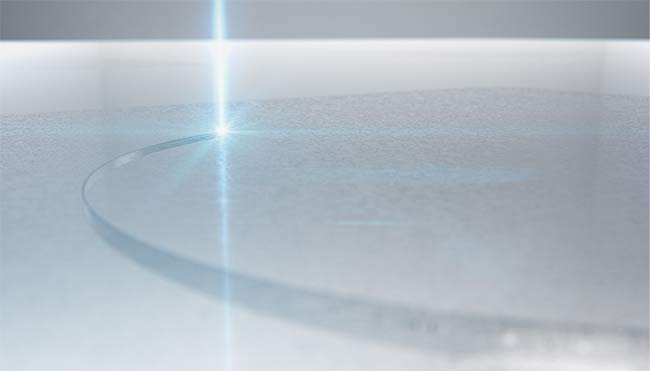
Laser processing tools are carving out a bigger role in cutting and welding glass in a variety of applications, including consumer electronics and automotive interiors. Courtesy of Corning Laser Technologies.
The ceremony symbolically happened in Mérida, Mexico, near the location where — 65 million years earlier — an asteroid had crashed and led to the extinction of the dinosaurs. If another asteroid were ever to hit Earth, the researchers said, the declaration would remain safely preserved in the glass disc, which could store up to 360 TB of data — 7000× the storage capacity of a double-layer Blu-ray Disc — and withstand temperatures up to 1832 °F.
Less than three weeks after the Year of Light ceremony was over, Aaron Ogus, a Microsoft distinguished engineer, visited Peter Kazansky, ORC’s project lead. Ogus proposed that ORC apply its 5D optical storage research to the task of addressing the long-term data storage needs that cloud technology is rapidly driving into the zettabytes.
Ogus said he had explored all sorts of “crazy, crazy” ideas to resolve the impending data storage crunch prior to learning about Kazansky’s research. Most of the ideas relied on expensive media. ORC’s 5D optical storage was different.
“It’s just glass. All the technology is in the writer and reader,” Ogus said. Further, because the data is stored on glass, the etched material requires no energy when at rest. This promised to advance Microsoft’s net-zero carbon ambitions while making the technology resilient to an electromagnetic pulse — a feature attractive to governments.
The engineer’s proposal dramatically changed the course of the ORC team, which has since been joined by Microsoft Research Cambridge (MSR), with Ant Rowstron, also a Microsoft distinguished engineer, leading the research effort.
Kazansky said, “The main change was in understanding the requirements for moving our fundamental research to the real-world application.”
In September 2017, Microsoft announced a collaboration between MSR and the University of Southampton — called Project Silica. The project is using ultrafast lasers to revolutionize the data storage industry with 5D memory glass and a promise of “information immortality.” This is just one example of how new trends in laser processing are reshaping the glass industry, through etching data onto glass, 3D glass cutting, or welding glass to metal.
Laser etching
The 5D memory glass has been called “Superman memory crystal.” Its supremely durable quality is especially important when considering the alternatives. Magnetic tape, for example, remains the main technology for archiving data and for cold data storage. However, whereas magnetic tape has a shelf life of 15 to 20 years and is vulnerable to fire and water damage, 5D memory glass offers chemical and thermal durability and a virtually unlimited lifetime, Kazansky said.
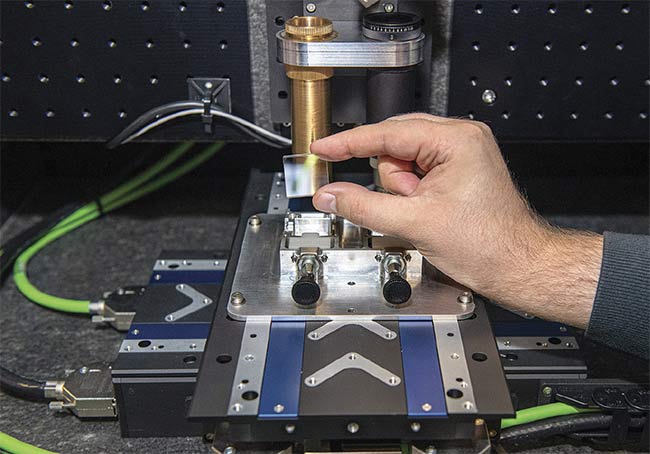
Microsoft Research Cambridge is applying femtosecond lasers to the task of etching data onto silica. The technology could revolutionize data storage by producing 5D memory glass capable of offering
‘information immortality.’ Courtesy of Microsoft.
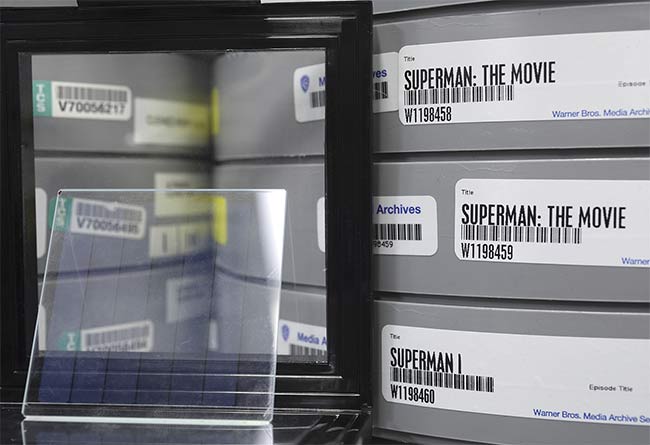
Laser-etched 5D memory glass has been called ‘Superman memory crystal’ for its supremely durable quality. It is also a high-volume medium. Given these qualities, a proof of concept for the technology stored Warner Bros.’ entire ‘Superman’ movie on a piece of glass measuring 75 × 75 × 2 mm. Courtesy of Microsoft.
Given this superpower, Project Silica’s first proof of concept in 2019 involved laser etching the entirety of Warner Bros.’ “Superman” movie onto a piece of glass measuring 75 × 75 × 2 mm. The process, Kazansky said, was enabled by turnkey, industrial-grade diode-pumped ultrafast lasers such as PHAROS by Light Conversion and Satsuma by Amplitude. Also key to 5D optical storage was the discovery of birefringence in quartz glass produced by self-assembled nanostructures during ultrafast laser writing.
The process involves focusing a laser beam inside the bulk of the glass to create nanostructures, such as nanogratings or prolate-shaped nanovoids. Kazansky said the mechanism of anisotropic nanostructure formation is still a puzzle, but it can be mediated by electron plasma formation close to the intensity ionization threshold. The orientation of nanostructures can be controlled by light polarization, which produces birefringence. This birefringence is characterized by slow axis azimuth and retardance, which are two parameters, in addition to three spatial coordinates, that result in 5D optical storage.
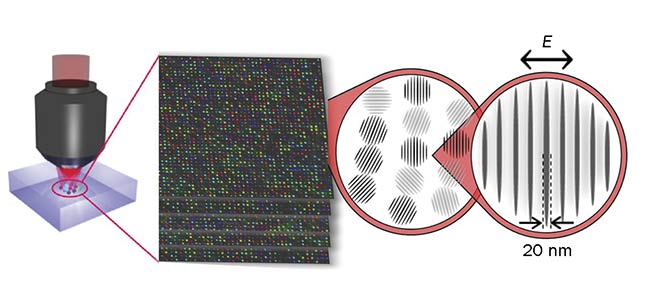
The 5D optical storage process is enabled by industrial-grade diode-pumped ultrafast lasers, which produce self-assembled nanostructures. Courtesy of Peter Kazansky.
Currently, the main limitation of 5D optical storage is its slow writing speed. But Kazansky predicts the speed could improve by at least one order of magnitude by optimizing the writing parameters, material properties, and parallel processing. In fact, because of Project Silica, researchers have managed to improve writing speed by three orders of magnitude in just the last year. In Kazansky’s estimation, 5D optical storage remains about five years away from commercialization, which hinges on the price of lasers decreasing, as well as further engineering of write and read heads.
If correct, his estimation would make
5D optical storage commercially accessible just as cloud services push the limitations for existing data storage technologies. According to market research company International Data Corp., the amount of data generated annually is projected to grow from 33 ZB in 2018 to 175 ZB in 2025.
Mechanical versus laser cutting
Additional major growth areas for laser-processed glass are flat-panel displays, automotive windshields, electrochromatic mirrors and displays, and medical applications — primarily microfluidics test plates. In many cases, processing revolves around the cutting of the glass, where the main competition for lasers remains mechanical scribe-and-break technologies as well as blade dicing, according to experts at Coherent and Corning Laser Technologies (CLT).
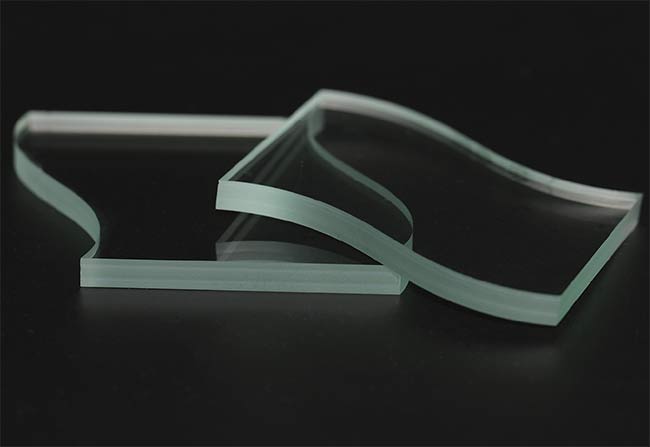
Flat glass cut with ultrashort-pulse lasers. Courtesy of Coherent.
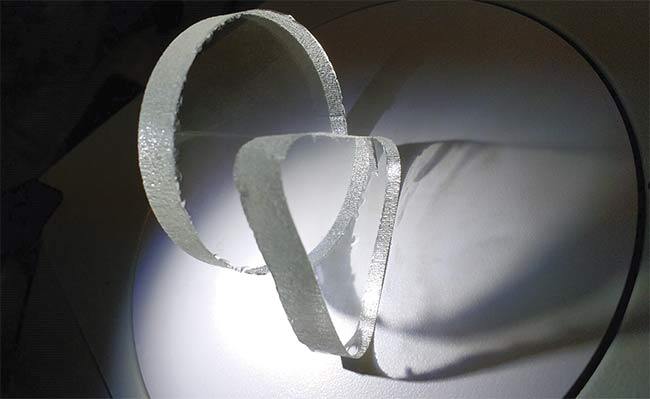
Pulsed lasers are effective tools for shaping optical glass. Courtesy of Glass Technologies Services.
“Mechanical glass cutting is still the dominant technique for cutting glass and will likely remain so for some time,” said Dirk Müller, director of strategic marketing at Coherent. “It is hard to beat a small metal wheel when it comes to cost.”
Mechanical glass cutting, however, is always a two-step process: first scribing and then bending the glass to mechanically separate parts. “The bending creates glass particles that can be an issue in some sensitive applications,” Müller said. “Laser-based glass cutting can be very fast, have much reduced particle generation, and can also allow for very tight curves, as well as cutting inside features. In high-volume applications, laser-based cutting can be more economical than mechanical cutting. Furthermore, very thin glass (<100 µm) is very difficult to cut mechanically.”
CO2 and ultrafast lasers are predominately used for cutting glass. CO2 lasers, with their strong temperature gradient, are better suited for flat glass when it is put under strong tension and combined with a cooling liquid or glass. They cut quickly, but because the beam must be elongated, the process does not allow for curves. “The direction of elongation determines the direction of crack propagation and limits the radius of curvature,” Müller said. CO2 lasers also create sharp glass edges that need to be ground or polished.
Tougher cuts
Due to the fact that CO2 laser energy is absorbed in the very top layer of the glass, these tools are not well suited to cut a stack of glass sheets with interstitial layers, Müller said. Coherent’s SmartCleave system uses ultrashort-pulse lasers to separate brittle and transparent materials via a curtain of filaments generated inside the glass.
“Glass processing itself is a rather small portion of the total laser tool market for material processing,” said Christian Wagner, product line manager at CLT. “We benefit from the development driven by larger market segments for laser tools such as sheet metal processing, microelectronics, and others. The ongoing trend with new laser sources is toward ever higher laser pulse energy and peak power, which we can utilize for glass processing by tailoring the spatial and temporal laser beam properties so that we achieve an optimized laser-glass interaction.”
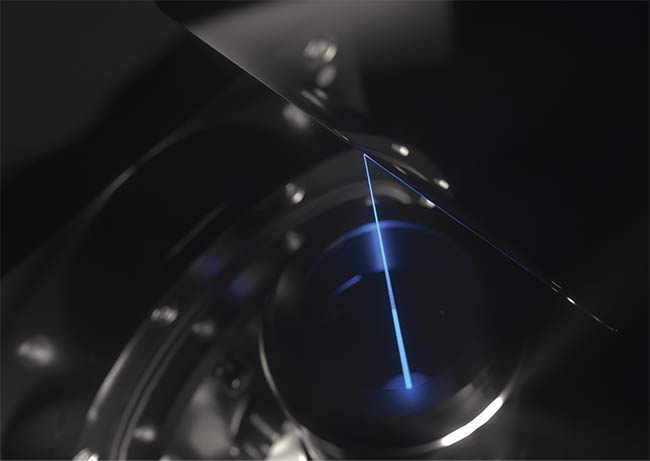
Ultrashort-pulse lasers cut glass through localized perforation rather than ablation. The technology is
attracting interest for the manufacture of high-end auto display panels and could see broader adoption over the next five years. Courtesy of Corning Laser Technologies.
For glass substrates that are too thick to be practicably processed by thermal stress cutting or micromachining techniques, researchers at the University of Leeds
and Glass Technologies Services (GTS)
in Sheffield, England, are developing a new cutting technique with 532-nm pulsed laser sources.
The method, known as Bright Slice, relies on focusing a shaped beam into a transparent material to create fractures preferentially in one direction, said David Eustice, senior technologist at GTS. “This differs from cutting by micromachining, which ablates away material from the laser side, [or] thermal stress cutting, where a laser is used to extend an initial fracture by controlling thermal expansion.”
To cut three-dimensional glass surfaces, ultrafast lasers can create a curtain of filaments in the glass that serve as a perforation line. The glass can then be separated either mechanically or by introducing strain along the perforation line, Müller said.

Heriot-Watt University and its industry partners are developing a laser process technology to weld glass to metal using diode-pumped solid-state IR lasers pulsed in the picosecond and femtosecond regions. The technique targets the laser beam on the material and pre-compensates for optical aberrations posed by the thick glass through which the beam must pass. It could be used for welding transparent crystalline materials, glasses, metals, and ceramics. HAZ: heat-affected zone. Courtesy of Heriot-Watt University.
In 2018, CLT announced its nanoPerforation technology, which uses an ultrashort-pulse laser to cut glass through localized perforation rather than through ablation. It is combined with a five-axis beam delivery system to ensure the laser remains perpendicular to the glass surface.
Last summer, Taiwanese display solutions provider Innolux Corp. announced it would use the nanoPerforation technology to manufacture high-end auto display panels. CLT key account manager Bernhard Mögele expects 3D cutting to become commonplace within five years. Coherent is also refining 3D glass-cutting solutions using autofocus systems and robots.
Bonding metal to glass
Another glass-processing challenge that lasers are close to resolving is the welding of glass to metal. Researchers at Heriot-Watt University in Edinburgh have been working with a consortium of industry partners, including Oxford Lasers and Coherent Scotland, to develop a solution.
“The welding of glass to metal encounters specific challenges due to the significant difference in their material properties; furthermore, the opacity of metallic substrates to the laser wavelength does limit the optical path by which laser weld may be achieved,” said Owen McGann, a senior technologist for GTS, which is working to commercialize the laser process.
In a collaboration dubbed Project UltraWELD, the researchers are examining various routes for surface preparation, as well as alternative welding parameters that are less susceptible to surface conditions. They have identified ways to minimize the impact of surface effects and have worked with materials suppliers to identify suitable techniques for surface preparation, McGann said.
The process involves ultrafast diode-pumped solid-state IR
lasers pulsed in the picosecond and femtosecond region extending to megahertz output. Critical to the process are Oxford Lasers’ proprietary optical systems designed to target the laser beam on the material and pre-compensate for optical aberrations posed by the thick glass through which the beam must pass.
The UltraWELD process aims to eliminate adhesives from joints. Unlike adhesives, which require curing or setting, the bond formed when lasers weld glass to metal achieves full strength immediately and does not outgas during the cure
process.
“There are no fundamental differences between welding glass to metal and welding ceramic or another opaque inorganic material to glass,” McGann said. “As such, the UltraWELD technology is applicable to a wide range of potential applications extending to the welding of transparent crystalline materials, glasses, metals, and ceramics.”
He said Oxford Lasers has demonstrated that its UltraWELD technology can weld optical components into their assemblies and hermetically seal organic LED panels between two sheets
of ultrathin flexible glass. The company aims to deploy the technology to target markets during the first quarter of 2021.
www.linkedin.com/in/james-schlett